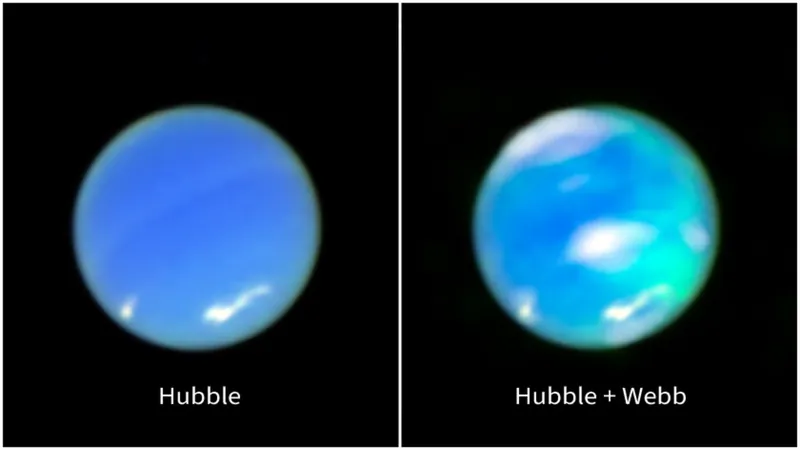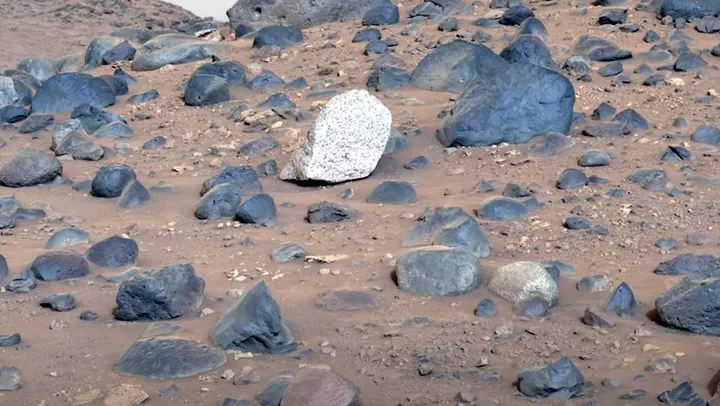
James Webb Space Telescope Unveils Stunning Images of Neptune's Mysterious Auroras
2025-03-26
Author: Jia
In a groundbreaking discovery, astronomers have for the first time successfully captured direct images of Neptune’s elusive auroras, showcasing the planet's stunning atmospheric phenomena. This achievement, made possible by the advanced capabilities of the James Webb Space Telescope (JWST), has provided new insights into the dynamics of this distant ice giant.
For many years, scientists speculated about the presence of auroras on Neptune, drawing on evidence from the Voyager 2 flyby in 1989 and comparisons with similar activities observed on nearby gas giants like Jupiter, Saturn, and Uranus. However, it took the JWST’s powerful near-infrared sensitivity to bring Neptune's auroras into clearer focus.
Henrik Melin from Northumbria University, who led the study, expressed his astonishment: “The detail and clarity captured in the auroral images were beyond what we expected.” He noted that Neptune's auroras are uniquely positioned due to the planet's highly tilted magnetic field, which leads to unusual auroral displays that can emerge at mid-latitudes instead of being confined solely to the poles, as seen on other planets.
Utilizing the Near-Infrared Spectrograph (NIRSpec) aboard the JWST, researchers were able to analyze the light emitted by the planet’s ionosphere — the charged layer of its atmosphere where auroras originate. Remarkably, they detected emissions of the trihydrogen cation (H₃⁺), a molecule that is a key indicator of auroral activity. This ion not only plays a vital role in planetary auroras but is also one of the most abundant ions found throughout the universe.
As JWST scientist Heidi Hammel remarked, “The detection of H₃⁺ confirms what we long theorized about auroras on Neptune. This could not have been achieved without the unique capabilities of Webb.”
In addition to capturing these remarkable images, the team was able to measure Neptune’s upper atmospheric temperature for the first time since the Voyager 2 mission. The findings revealed that Neptune’s upper atmosphere has cooled significantly, with temperatures in 2023 reflecting a drop of several hundred degrees since 1989. This reduction in temperature might explain the difficulties previously faced in observing Neptune's auroras. Typically, warmer atmospheric conditions lead to more active auroras due to increased energy in the ions.
Looking ahead, astronomers are eager to further explore Neptune and its auroras with the JWST, which has opened a new frontier in our understanding of this enigmatic planet. Leigh Fletcher, co-author of the study, emphasized, “As we plan future missions to Uranus and Neptune, it’s clear that instruments capable of capturing infrared wavelengths will be essential to continue unraveling the mysteries of their auroras.
This monumental breakthrough heralds a new era in planetary science, offering a glimpse into the intricate processes at play in one of our solar system's most intriguing and distant worlds. As scientists continue to analyze the data from the Webb telescope, more discoveries about Neptune and its unique atmosphere are sure to emerge, deepening our understanding of the cosmos.




 Brasil (PT)
Brasil (PT)
 Canada (EN)
Canada (EN)
 Chile (ES)
Chile (ES)
 Česko (CS)
Česko (CS)
 대한민국 (KO)
대한민국 (KO)
 España (ES)
España (ES)
 France (FR)
France (FR)
 Hong Kong (EN)
Hong Kong (EN)
 Italia (IT)
Italia (IT)
 日本 (JA)
日本 (JA)
 Magyarország (HU)
Magyarország (HU)
 Norge (NO)
Norge (NO)
 Polska (PL)
Polska (PL)
 Schweiz (DE)
Schweiz (DE)
 Singapore (EN)
Singapore (EN)
 Sverige (SV)
Sverige (SV)
 Suomi (FI)
Suomi (FI)
 Türkiye (TR)
Türkiye (TR)
 الإمارات العربية المتحدة (AR)
الإمارات العربية المتحدة (AR)